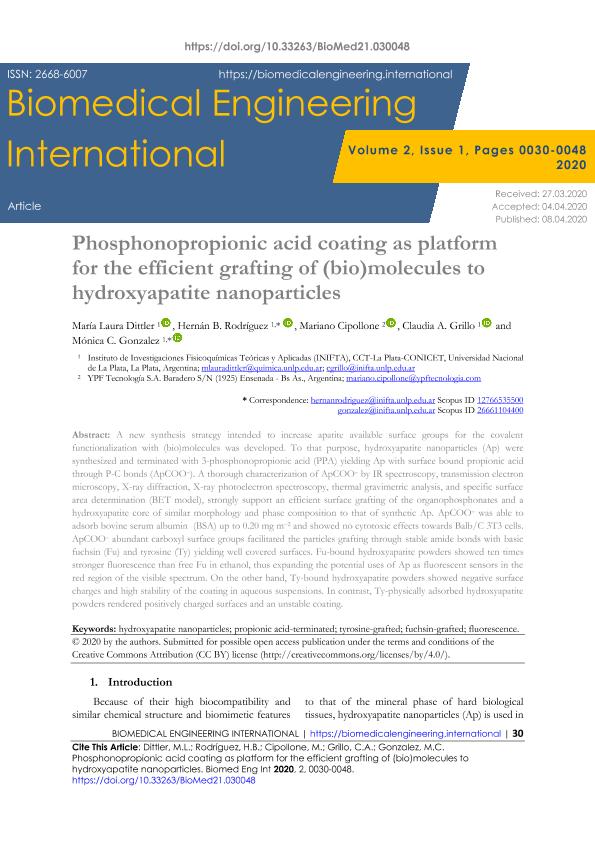Artículo
Phosphonopropionic acid coating as platform for the efficient grafting of (bio)molecules to hydroxyapatite nanoparticles
Dittler, Maria Laura ; Rodriguez, Hernan Bernardo
; Rodriguez, Hernan Bernardo ; Cippollone, Mariano; Grillo, Claudia Alejandra
; Cippollone, Mariano; Grillo, Claudia Alejandra ; Gonzalez, Monica Cristina
; Gonzalez, Monica Cristina
 ; Rodriguez, Hernan Bernardo
; Rodriguez, Hernan Bernardo ; Cippollone, Mariano; Grillo, Claudia Alejandra
; Cippollone, Mariano; Grillo, Claudia Alejandra ; Gonzalez, Monica Cristina
; Gonzalez, Monica Cristina
Fecha de publicación:
04/08/2020
Editorial:
Asociación AMG Transcend
Revista:
Biomedical Engineering International
ISSN:
2668-6007
Idioma:
Inglés
Tipo de recurso:
Artículo publicado
Clasificación temática:
Resumen
A new synthesis strategy intended to increase apatite available surface groups for the covalent functionalization with (bio)molecules was developed. To that purpose, hydroxyapatite nanoparticles (Ap) were synthesized and terminated with 3-phosphonopropionic acid (PPA) yielding Ap with surface bound propionic acid through P-C bonds (ApCOO– ). A thorough characterization of ApCOO– by IR spectroscopy, transmission electron microscopy, X-ray diffraction, X-ray photoelectron spectroscopy, thermal gravimetric analysis, and specific surface area determination (BET model), strongly support an efficient surface grafting of the organophosphonates and a hydroxyapatite core of similar morphology and phase composition to that of synthetic Ap. ApCOO– was able to adsorb bovine serum albumin (BSA) up to 0.20 mg m–2 and showed no cytotoxic effects towards Balb/C 3T3 cells. ApCOO– abundant carboxyl surface groups facilitated the particles grafting through stable amide bonds with basic fuchsin (Fu) and tyrosine (Ty) yielding well covered surfaces. Fu-bound hydroxyapatite powders showed ten times stronger fluorescence than free Fu in ethanol, thus expanding the potential uses of Ap as fluorescent sensors in the red region of the visible spectrum. On the other hand, Ty-bound hydroxyapatite powders showed negative surface charges and high stability of the coating in aqueous suspensions. In contrast, Ty-physically adsorbed hydroxyapatite powders rendered positively charged surfaces and an unstable coating.
Archivos asociados
Licencia
Identificadores
Colecciones
Articulos(INIFTA)
Articulos de INST.DE INV.FISICOQUIMICAS TEORICAS Y APLIC.
Articulos de INST.DE INV.FISICOQUIMICAS TEORICAS Y APLIC.
Citación
Dittler, Maria Laura; Rodriguez, Hernan Bernardo; Cippollone, Mariano; Grillo, Claudia Alejandra; Gonzalez, Monica Cristina; Phosphonopropionic acid coating as platform for the efficient grafting of (bio)molecules to hydroxyapatite nanoparticles; Asociación AMG Transcend; Biomedical Engineering International; 2; 1; 4-8-2020; 30-48
Compartir
Altmétricas



